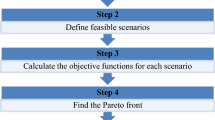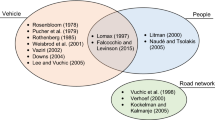Abstract
To minimize travel time of emergency vehicles on the way and improve efficiency of emergency response, an emergency vehicle route oriented signal coordinated control model with two-level programming was proposed based on the different priority types and priority levels of emergency vehicles. The upper level is the dynamic offset model of emergency vehicles, and the lower level is the green wave model of emergency vehicles. At dynamic offset level, latter phase was calculated based on the queue length ahead of the emergency vehicles and their arrival time, in which the former phase was the reference object. At route green wave level, maximum bandwidth of the route of emergency vehicles was calculated, based on the turning movement characteristics and its corresponding capacity reduction. Furthermore, the two-level programming model solution is obtained with genetic algorithm. Finally, simulation results of three control strategies, which are no-signal priority control strategy, isolated control priority strategy and coordinated priority control strategy in this paper, were obtained in micro-traffic simulation software VISSIM, with the case including three intersections in Suzhou roads as the emergency vehicles route. From the simulation results we can conclude that compared to no-signal priority control strategy, coordinated priority strategy can reduce delay, travel time, queue length and stops of emergency vehicles by 27,18, 36 and 38%, respectively, and the average delay of total vehicles at intersection can be reduced by 20%; compared to isolated control priority strategy, these numbers are 14, 6, 12, 21 and 22%, respectively, which means great improvement, and influence on social background traffic was also considered in it.











Similar content being viewed by others
References
Finogeev AG, Parygin DS, Finogeev AA (2017) The convergence computing model for big sensor data mining and knowledge discovery. Human Centric Comput Inf Sci 7(1):11
Ghanim MS, Abulebdeh G (2015) Real-time dynamic transit signal priority optimization for coordinated traffic networks using genetic algorithms and artificial neural networks. J Intell Transp Syst 19(4):327–338
Hall T, Box PO, Best M (2007) Evaluation of emergency vehicle preemption strategies on a coordinated actuated signal system using hardware-in-the-loop simulation[C]. In: Transportation research board 86th annual meeting
He Q, Head KL, Ding J (2011) Heuristic algorithm for priority traffic signal control. Transp Res Rec J Transp Res Board 2259:1–7
Jiang G, Liang Y, Guan J, Wei R, Li ZH, Gong YJ (2008) Bus signal and VIP vehicle emergency priority at intersections in Beijing olympic Center. J Transp Syst Eng Inf Technol 06:101–106
Lee JK, Jeong YS, Park JH (2015) s-ITSF: a service based intelligent transportation system framework for smart accident management. Human Centric Comput Inf Sci 5(1):34
Ma W, Ni W, Head L, Zhao J (2013) Effective coordinated optimization model for transit priority control under arterial progression. Transp Res Rec J Transp Res Board 2356:71–83
Mirchandani PB, Lucas DE (2004) Integrated transit priority and rail/emergency preemption in real-time traffic adaptive signal control. Intell Transp Syst J 8(2):101–115
Mu K, Hui F, Zhao X (2016) Multiple vehicle detection and tracking in highway traffic surveillance video based on SIFT feature matching[J]. J Inf Process Syst 12(2):183–195
Nelson EJ, Bullock D (2000) Impact evaluation of emergency vehicle preemption on signalized corridor operation: an evalution. Transp Res Rec J Transp Res Board 1727:1–11
Qin X, Khan AM (2012) Control strategies of traffic signal timing transition for emergency vehicle preemption. Transp Res Part C Emerg Technol 25(25):1–17
Wang D, Zhu H, Yiming B (2011) Bus signal priority method at arterial signal progression. J Southeast Univ (Natural Science Edition) 41(4):859–865
Wu E, Xiaoguang Y, Zhen W et al (2008) Parameters co-optimization for artery coordinated control based on genetic algorithm[J]. J TongJi Univ (Natural Science) 36(7):921–926
Xie B, Hu Z, Zhao H (2011) Two-phase model of emergency vehicle signal preemption at intersection. J Syst Eng 04:492–499
Yang Z, Sun X, Sun P (2011) Signal priority control strategy and implementation for emergency vehicle an single intersection under traffic accidents. J Jilin Univ 03:640–644
Han Y, Xing B, Yao J et al (2015) Optimal model of regional traffic signal control under mixed traffic flow condition. J Traffic Transp Eng 15(1):119–126
Yun I, Park BB, Lee CK et al (2012) Comparison of emergency vehicle preemption methods using a hardware-in-the-loop simulation. Ksce J Civ Eng 16(6):1057–1063
Zhang X, He B (2016) Emergency vehicles signal priority control based on loop to progressively phase coordination. Appl Res Comput 33(7):1983–1986
Zhang D, Han J, Li C, Wang J, Li X (2016) Detection of co-salient objects by looking deep and wide. Int J Comput Vis 120(2):215–232
Zhao Y, Ding D, Chen R (2016) A discontinuous Galerkin time domain integral equation method for electromagnetic scattering from PEC objects. IEEE Trans Antennas Propag 64(6):2410–2417
Zheng Y, Jeon B, Xu D, Wu QMJ, Zhang Hui (2015) Image segmentation by generalized hierarchical fuzzy C-means algorithm. J Intell Fuzzy Syst 28(2):4024–4028
Zhengi Y, Jeon B, Zhang J, Chen Y (2015) Adaptively determining regularisation parameters in non-local total variation regularisation for image denoising. Electron Lett 51(2):144–145
Acknowledgements
This study was funded by MOE (Ministry of Education in China) Project of Humanities and Social Sciences (17YJCZH225) “Emergency oriented multi-objective traffic management and control model at urban area in the environment of big data”. This study was funded by the humanistic and social science research funding of University of Shanghai for Science and Technology (SK17YB05).
Author information
Authors and Affiliations
Corresponding author
Ethics declarations
Conflict of interest
The authors declare that they have no conflict of interest.
Ethical approval
This article does not contain any studies with human participants or animals performed by any of the authors.
Informed consent
Informed consent was obtained from all individual participants included in the study.
Additional information
Communicated by J. Park.
Prof. Jin Wang mainly contributed to this paper in the part of simulation and proofreading.
Rights and permissions
About this article
Cite this article
Yao, J., Zhang, K., Yang, Y. et al. Emergency vehicle route oriented signal coordinated control model with two-level programming. Soft Comput 22, 4283–4294 (2018). https://doi.org/10.1007/s00500-017-2826-x
Published:
Issue Date:
DOI: https://doi.org/10.1007/s00500-017-2826-x




